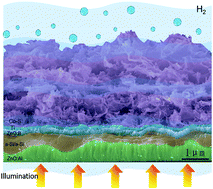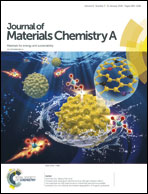Ti/Co-S catalyst covered amorphous Si-based photocathodes with high photovoltage for the HER in non-acid environments†
Abstract
Making highly efficient photoelectrodes for a photoelectrochemical (PEC) water splitting reaction is vitally important for bringing solar/electrical-to-hydrogen energy conversion processes into reality. Active and stable catalysts in the photoelectrode are the key component in PEC devices. Although most hydrogen evolution catalysts exhibit excellent performance in acid solutions, earth abundant oxygen evolution catalysts are generally unstable. Therefore, the elaborate design of highly active and stable photocathodes possessing great onset potential in non-acid environments is imperative. Here, we report that magnetron sputtering and electrochemical-deposition preparation methods are compatible with photo-absorbers for depositing titanium (Ti)/cobalt–sulfide (Co–S) catalyst on amorphous silicon/amorphous silicon (a-Si/a-Si) tandem solar cells, realizing a stable, low-cost, and efficient photocathode for water splitting in non-acid solutions. This photocathode exhibits a high photocurrent onset potential of 1.78 V vs. reversible hydrogen electrode (RHE) in alkaline and neutral electrolyte, with a photocurrent of 6.34 mA cm−2 at 0 V vs. RHE. The facile preparation of this highly active a-Si/a-Si/Ti/Co–S photocathode paves the way to integrate them into various oxygen evolution catalysts to develop highly efficient, low-cost, and monolithic PEC solar water splitting devices.

- This article is part of the themed collection: Journal of Materials Chemistry A Advisory Board Collection


 Please wait while we load your content...
Please wait while we load your content...